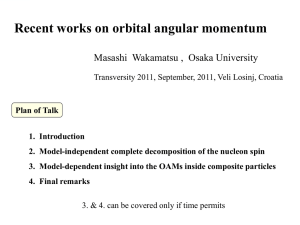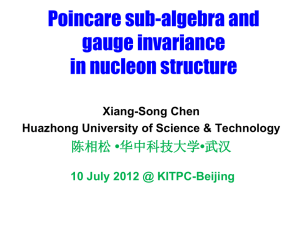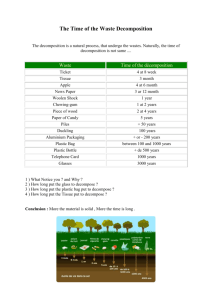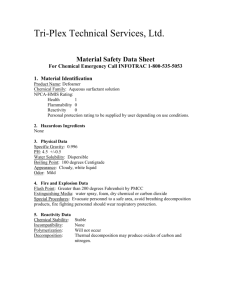ppt
advertisement
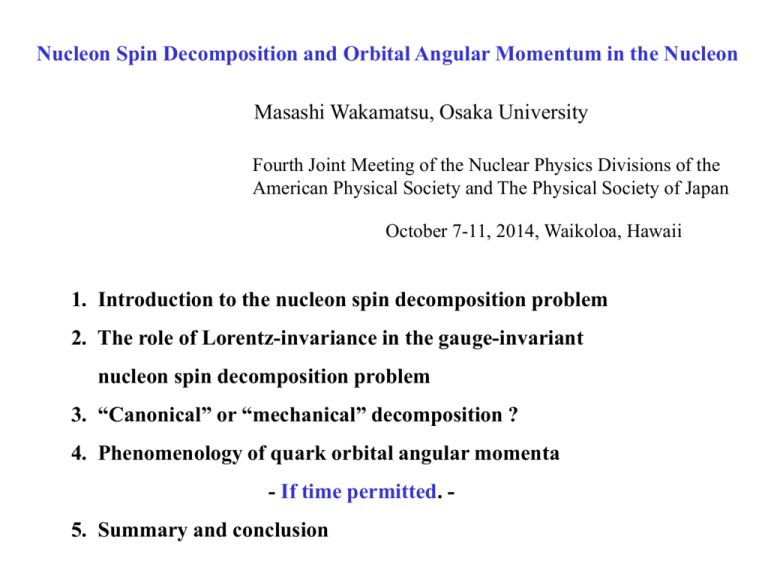
Nucleon Spin Decomposition and Orbital Angular Momentum in the Nucleon Masashi Wakamatsu, Osaka University Fourth Joint Meeting of the Nuclear Physics Divisions of the American Physical Society and The Physical Society of Japan October 7-11, 2014, Waikoloa, Hawaii 1. Introduction to the nucleon spin decomposition problem 2. The role of Lorentz-invariance in the gauge-invariant nucleon spin decomposition problem 3. “Canonical” or “mechanical” decomposition ? 4. Phenomenology of quark orbital angular momenta - If time permitted. 5. Summary and conclusion 1. Introduction to nucleon spin decomposition problem Although one might think it a little “academic problem”, to get a complete decomposition of nucleon spin is a fundamentally important homework of QCD. In fact, if our research ends up without accomplishing this task, a tremendous efforts since the first discovery of nucleon spin crisis would go up in smoke. Unfortunately, this is an extremely delicate problem, which has rejected a clear answer for more than 20 years since the first extensive analysis in the paper by • R.L. Jaffe and A.V. Manohar, Nucl. Phys. B337, 509 (1990). Recently, two reviews appeared to overview controversial status of the problem : • E. Leader and C. Lorcé, Phys. Rept. 541, 163 (2014) [arXiv : 1309.4235]. • M. Wakamatsu, Int. J. Mod. Phys. A29, 1430012 (2014) [arXiv:1402.4193]. Central questions in the nucleon spin decomposition problem 1) Can the total gluon angular momentum be gauge-invariantly decomposed into the spin and orbital parts without causing conflict with the textbook negative statement on the similar question on the total photon spin ? 2) Are there infinitely many decompositions of the nucleon spin ? If not, what physical principle favors one particular decomposition among many candidates ? 3) Among the two different decompositions, i.e. the “canonical” type decomposition and the “mechanical” type decomposition, which can we say is more physical ? More “physical” here means that it is closer to direct observation. The third issue was discussed in some detail in our aforementioned review. Concerning the first two issues, a clear answer was given in our latest paper. • M. Wakamatsu, arXiv:1409.4474 [hep-ph]. Key factors are : The existence of a particular spatial direction in DIS physics, i.e. the direction of parent nucleon momentum. Lorentz-boost-invariance of PDFs along this direction. two popular decompositions of the nucleon spin common Each term is not separately gauge-invariant ! No further GI decomposition ! two popular decompositions of the nucleon spin : - continued - different An especially annoying observation here was that, since one must inevitably conclude that Now we know the answer of this puzzle. • M.W. , Phys. Rev. D81 (2010) 114010. potential angular momentum characterizes the difference between and . The recent intensive dispute began with Chen et al.’s papers. • X.-S. Chen et al., Phys. Rev. Lett. 103, 062001 (2009) ; 100, 232002 (2008). basic idea which is a sort of generalization of the familiar decomposition of photon field in QED into the transverse and longitudinal components : Their decomposition is given in the following form : In fact, each term is separately gauge-invariant ! - GI version of Jaffe-Manohar decomp. - Soon after, we noticed that the way of gauge-invariant decomposition of nucleon spin is not necessarily unique, and proposed another G.I. decomposition : • M.W. , Phys. Rev. D81 (2010) 114010. where “potential angular momentum” The QED correspondent of is the orbital angular momentum carried by electromagnetic potential, appearing in the famous Feynman paradox. An arbitrariness of the spin decomposition arises, because this potential angular momentum term is solely gauge-invariant ! Shifting it to the quark OAM part Ji J-M or Chen We are thus left with two gauge-invariant decompositions of the nucleon spin : “canonical” decomposition with “mechanical” decomposition with [Word of caution] These decompositions are based on the familiar transverse-longitudinal decomposition of the gauge field. However, the transverse-longitudinal decomposition is given only after fixing the Lorentz-frame of reference. ( - breaks covariance - ) 2. The role of Lorentz-invariance in the GI nucleon spin decomposition problem The most general forms of gauge-invariant complete decomposition of the nucleon spin, which have “seemingly” covariant appearances, was given in • M.W. , Phys. Rev. D83, 014012 (2011) “canonical” decomposition where “mechanical” decomposition where Basis decomposition of gauge potential To obtain the these “seemingly” covariant complete decompositions, we need to impose very general conditions only : and • Actually, these conditions are not enough to fix the decomposition uniquely ! • It is nevertheless true that one of our decompositions, i.e. the “canonical” type decomposition contains the LC-gauge motivated Bashinsky-Jaffe (or Hatta) decomposition as well as the Coulomb-gauge motivated Chen decomposition, after a suitable choice of the Lorentz frame. [critiques to non-uniqueness nature] It was criticized by several researchers that our formal decomposition of the gauge field into its physical and pure-gauge components is not unique at all and there are in principle infinitely many such decompositions, which in turn leads to infinitely many decomposition of the nucleon spin. According to • X. Ji, Y. Xu, and Y. Zhao, arXiv : 1205.0156 [hep-ph]. the arbitrariness of the decomposition comes from the path-dependence of the Wilson line, which is necessary for explicitly fixing the decomposition of the gauge field into the physical and pure-gauge components. Another argument in favor of the existence of infinitely many decomposition of the nucleon spin was advocated by • C. Lorcé, Phys. Lett. B719, 185 (2013). based on what-he-call the Stueckelberg symmetry, which changes both of and , while leaving their sum intact. In a recent paper • X. Ji, J.-H. Zhang, and Y. Zhao, Phys. Rev. 111 (2013) 112002. Ji et al. argued that the total gluon helicity in a polarized proton is shown to be large momentum limit of a gauge-invariant operator , with being the usual transverse component of the gauge potential. (1) First, they pointed out that, for the abelian case, the gluon spin operator which corresponds to DIS measurements, can be expressed in the form : with (2) Next, they showed that the above operator is just the IMF limit of , From this fact, they concluded that, to identify one must have the following conditions : IMF & physical gauge ( as the gluon helicity, LC gauge) The statement is nothing wrong, but it has a danger of causing a misunderstanding. In fact, the gluon spin, or more generally, the longitudinally polarized gluon distribution, must be a Lorentz-frame independent quantity. This is clear from the fact that the measurement of these quantities is carried out in the laboratory frame not in the IMF ! This especially means that the gluon spin or the longitudinally polarized gluon distribution should not depend on the magnitude of nucleon momentum . To see the importance of the constraint from Lorentz-frame independence, it would be instructive to compare a vital difference between the various definitions of the “physical” component of the gauge field : • Y. Hatta, X. Ji, and Y. Zhao, Phys. Rev. D89 (2014) 085030. • LC gauge motivated • temporal gauge motivated • spatial axial gauge motivated • Coulomb gauge motivated A distinguishing feature of the LC gauge motivated choice is that it is invariant under the Lorentz-boost along the 3-direction, i.e. the direction of nucleon momentum ! In fact, under the Lorentz boost along the 3-direction we can easily verify that ( for On the contrary, any other definitions of ) is not invariant under the boost. We therefore conclude that what plays a key role in the uniqueness problem of the GI decomposition of the nucleon spin is the Lorentz-frame independence. We should have noticed earlier that not only the gauge-invariance but also the Lorentz-frame independence is an important criterion of observability ! Still noteworthy observation is as follows. In the free field limit with we see that This indicates perturbative equivalence of these three. In fact, the 1-loop anomalous dimension of the gluon spin operators are just the same. • M.W., Phys. Rev. D87 (2013) 094035. Now the problem of the gluon spin has been essentially demystified, but we still have two choices for the complete decomposition of the nucleon spin : “canonical” one or “mechanical” one Often-claimed advantages of “canonical” decomposition. (1) Each piece of the decomposition satisfies the SU(2) commutation relation (2) is compatible with free partonic picture of constituent orbital motion. The 1st advantage was already denied for the massless particle. • M.W., Int. J. Mod. Phys. A29, 1430012 (2014). • W.-M. Sun, arXiv : 1407.2035 [quant-ph]. In the following, I therefore focus on the 2nd issue. Widespread superstition originating from the “appearance” of the two OAMs : • The “mechanical” OAM appears to contains quark-gluon interaction. • The “canonical” OAM does not contain quark-gluon interaction, so that it seems compatible with the partonic interpretation. That this understanding is not necessarily correct was shown in Sect.6 of • M.W., Int. J. Mod. Phys. A29, 1430012 (2014). Although sounds paradoxical, what contains the interaction term, or the potential angular momentum, is rather the “canonical” OAM than the “mechanical” one. One might suspect that this kind of argument is just a matter of philosophy. Naturally, what discriminates physics from philosophy is observations ! 3. “Canonical” or “Mechanical” decomposition ? Historically, it was a common belief that the canonical OAM appearing in the Jaffe-Manohar decomposition would not correspond to observables, because they are not gauge-invariant quantities. This nebulous impression did not change even after a gauge-invariant version of the Jaffe-Manohar decomposition a la Bashinsky and Jaffe appeared. However, the situation has changed drastically after Lorcé and Pasquini showed that the canonical quark OAM can be related to a certain moment of a quark distribution function in a phase space, called the Wigner distribution. According to them, a natural definition of quark OAM density in the phase-space After integrating over , they found a remarkable relation where A delicacy here is that the Wigner distribution generally depends on the chosen path of the gauge-link connecting the points As shown by a careful study by Hatta, with the choice of a staple-like gauge-link in the light-front direction, corresponding to the kinematics of the semi-inclusive reactions or the Drell-Yan processes, the above quark OAM turns out to coincide with the (gauge-invariant) canonical quark OAM not the mechanical OAM : This observation holds out a hope that the canonical quark OAM in the nucleon would also be a measurable quantity, at least in principle. However, in a recent paper • A. Courtoy et al., Phys. Lett. B731 (2014) 141. Courtoy et al. throws a serious doubt on the practical observability of the Wigner function appearing in the above intriguing sum rule. According to them, even though may be nonzero in particular models and also in real QCD, its observability would contradict several observations : • it drops out in both the formulation of GPDs and TMDs ; • it is nonzero only for imaginary values of the quark-proton helicity amplitudes. At the least, their observations indicate that would not appear in the cross section formulas of any DIS processes at the leading order approximation. It appears to us that this takes a discussion on the observability of the canonical OAM back to its starting point ? What about observability of another OAMs, i.e. the mechanical OAMs, then ? already known (indirect) relation more direct relation with GPD due to Penttinen et al. (2000), Kiptily and Polyakov (2004), Hatta and Yoshida (2012) where An interesting observation by Kiptily and Polyakov WW part genuine twist-3 The WW part is represented by the forward limits of the 3 twist-2 GPDs as whereas the 2nd moment of the genuine twist-3 part of This means that the genuine twist-3 part of net mechanical quark OAM . vanishes ! does not contribute at all to the Putting it in another way, the net mechanical quark OAM is determined solely by three twist-2 PDFs Burkardt’s physical interpretation on the difference between two OAMs average transverse momentum and longitudinal OAM of quarks with generally path-dependent 3 paths with physical interest Semi-inclusive DIS (1) future-pointing staple LC path Drell-Yan (2) past-pointing staple LC path (3) straight-line path connecting and Burkardt showed the relation : In the LC gauge, and FSI Then, the r.h.s. can be interpreted as the change of transverse momentum for the struck quark by color Lorentz force when it leaves the target after being struck by the virtual photon in the semi-inclusive DIS processes. Similarly Lorentz force torque by Lorentz force FSI A comparison of two paths where, according to Ji while, according to Hatta with the definition of the physical component of the gluon field This is just the potential angular momentum in our general formalism : so that Here, due to the parity and time-reversal (PT) symmetry The above relation is consistent with our general relation What is important is that the canonical OAM is basically process-independent ! However, since both of say which of or and contains are generally nonzero, it is difficult to , i.e. the quark-gluon interaction term. We shall see, however This is not the case for the average transverse momentum ! In this case, we get the similar relation where potential momentum This formally gives However, the PT symmetry in this case gives that The definition of “canonical” transverse momentum is therefore not universal, i.e. process-dependent, while “mechanical” transverse momentum is zero. This clearly shows that what contains the FSI or ISI (quark-gluon interaction) is the canonical momentum and canonical OAM not the mechanical momentum and mechanical OAM, contrary to naïve expectation. Once, Brodsky proposed to clearly distinguish two types of Structure Functions. • S. J. Brodsky, Nucl. Phys. A827, 327c (2009). “static” structure function or PDF : computed directly from LC w.f.’s. “dynamic” structure function or PDF : contains FSI or ISI (like Sivers func.) Now, we can say “mechanical” OAM moment of “static” PDF “canonical” OAM moment of “dynamic” PDF Which can we say is more partonic ? Nonetheless, even though the “canonical” OAM is not an intrinsic or static property of the nucleon, owing to the existence of the factorization theorem, both types of OAMs would in principle be observables, or more precisely, “quasi-observables”. 4. Phenomenology of quark orbital angular momenta Lattice QCD studies of quark OAMs based on the Ji sum rule with LHPC and QCDSF-UKQCD Lattice QCD collaborations (2007-2010) - Connected Insertion (diagram) only, however - Inclusion of disconnected diagrams (Disconnected Insertion) • cQCD Collaboration : M. Deka et al., arXiv : 1312.4816 [hep-ph] Lattice QCD predictions with DI correction became closer to those of CQSM ! More complete Lattice QCD simulation must also pay attention to • • • • Finite volume effects Extrapolation to physical pion mass non-quenched (full QCD) simulation … “Another” nucleon spin puzzle ? Since this is an isovector quantity, it is free from DI corrections. All the Lattice QCD calculations (LHPC, QCDSF-UKQCD, cQCD) gives This contradicts the predictions of the standard quark models of SU(6) character including the MIT bag model. The latter gives Would the strong scale dependence of rescue this discrepancy ? • A.W. Thomas, Phys. Rev. Lett. 101, 102003 (2008). This is partially true but not enough, however. • M. W. and Y. Nakakoji, Phys. Rev. D77, 074010 (2008). • M. W., Eur. Phys. J. A44, 297 (2010). “canonical” OAM “mechanical” OAM ? downward LO evolution from LHPC a puzzle to be solved Does the strong scale dependence of rescue the discrepancy between the predictions of the Lattice QCD and those of low energy quark models ? Or does it indicate a significant numerical difference between the “canonical” and “mechanical” OAMs in the nucleon ? In any case, if the existence of the puzzle is confirmed by GPD measurements, it means that very mysterious nonperturbative chiral dynamics is hidden in this ordinary quantity . The reason is because the difference between the “canonical” and “mechanical” OAMs is characterized by the quark-gluon interaction term, which is however flavor-independent, thereby indicating that at least if the perturbative method of thinking is justified. 5. Summary and conclusion We have clarified the fact that what plays a key role in the gauge-invariant decomposition problem of the nucleon spin is the Lorentz-frame independence, or boost-invariance along the direction of the nucleon momentum. We have also carried out a comparative analysis of two nucleon spin decompositions, which are characterized by two types of OAMs, i.e. “canonical” OAMs & “mechanical” OAMs We have advocated a viewpoint which favors the mechanical OAMs rather than the canonical OAMs, since the former have closer connection with direct observables. However, one may be able to get some insight also into the canonical OAM, through twist-3 DIS mechanism, although not practically easy. Anyhow, when one talks about the OAMs of quarks and gluons in the nucleon, one must at the least be clearly conscious of which OAMs one is talking about. [Backup Slides] On the Lorentz-frame independence of PDF (based on Collins’ textbook) definition of PDF (with ) Since the r.h.s is scalar, it must be a function of The formula is invariant under scaling of that only the combination and : by an arbitrary positive factor, so is allowed : This gives which is invariant under the boost along the direction of the nucleon momentum. [Backup Slides] Now, the definition of the gluon spin operator corresponding to DIS measurements seems unique, so that there is only one (or two) nucleon spin decomposition. where It is gauge-invariant as well as Lorentz-boost invariant along the 3-direction. Any contradiction with the standard textbook knowledge ? Is the lack of full covariance an indication of the fact that the gluon spin is not a gauge-invariant quantity in a ordinary sense ? A key is the existence of particular spatial direction in the DIS observables ! - direction of nucleon momentum - Decomposition problem of the total photon angular momentum • S.J. Van Enk and G. Nienhuis, Europhys. Lett. 25, 497 (1994). • S.J. Van Enk and G. Nienhuis, J. Mod. Optics 41, 963 (1994). They argue that the total angular momentum of free electromagnetic field can gauge-invariantly decomposed into “spin” and “orbital” parts, . • This separation is not Lorentz invariant. • Neither nor does obey the SU(2) commutation relation. They are nevertheless separately measurable. It appears that the key is again the existence of a particular spatial direction in the measurement, i.e. the direction of paraxial laser beam. Their concluding remark : “The conclusion is that both “spin” and “orbital” angular momentum of a photon are well defined and separately measurable. This concerns all three components. However, only the components along the propagation direction can be measured by detecting the change in internal and external angular momentum of an atom, respectively”. It may be fun to inspect the physical contents of the resultant gluon spin operator. In the LC gauge , it reduces to We emphasize that the presence of the 2nd term is essential, because the 1st term alone is not invariant under the boost along the 3-direction. Jaffe once estimated the contributions of both terms in the bag model as well as in the quark model. • R.L. Jaffe, Phys. Lett. B365 (1996) 359. Jaffe already recognized that, since the sum is boost-invariant, the above can be calculated in any Lorentz frame, including the rest frame of the nucleon, provided that the above is the gauge potential in the LC gauge. What is curious here is the physical meaning of the peculiar 2nd term. Interestingly, it resembles the quantity : except the absence of the 3-component in . In the field of space and laboratory plasma physics, the above S is called the magnetic helicity, which gives a measure of the topological configuration of magnetic field. magnetic helicity = topological invariant • M. Berger, Plasma. Phys. Control. Fusion 41 (1999) B167. This might indicates that, if a topological configuration of the gluon field play some role in the gluon spin in the nucleon, it is through this 2nd term (?) Leaving aside such a speculation, a perturbative consideration gives transparent physical meaning of the term . Using the free field expansion of the gauge potential one can easily show that and Thus reduces to the ordinary helicity operator. [Backup Slides] Isovector OAM in the CQSM through the Ji relation with peculiar spin-isospin correlation [Backup Slides] Model-dependent nature of the OAM in a composite particle - in the absence of factorization theorem [Example] deuteron as the simplest composite system angular momentum decomposition of deuteron spin deuteron w.f. and S- and D-state probabilities The OAM contribution to the net deuteron spin is proportional to ! However, we know that the D-state probability is not a direct observable ! The “interior” of a bound state w.f. cannot be determined empirically. • R.D. Amado, Phys. Rev. C19 (1979) 1473 2-body unitary transformation arising in the theory of meson-exchange currents can change the D-state probability, while keeping the deuteron observables intact. • J.L. Friar, Phys. Rev. C20 (1979) 325. The D-state probability, for instance, depends on the cutoff of short range physics in an effective theory of 2-nucleon system. • S.K. Bogner et al., Nucl. Phys. A784 (2007) 79. See the figure in the next page ! Deuteron D-state probability in an effective theory Bogner et al, 2007




